Table of Contents
Guide

 Published by
Published by World Century Publishing Corporation 27 Warren Street, Suite 401-402, Hackensack, NJ 07601 Library of Congress Control Number: 2020938724
British Library Cataloguing-in-Publication Data A catalogue record for this book is available from the British Library. Supported by the Chinese Fund for the Humanities and Social Sciences Originally published in Chinese by Shanghai Chinese Classics Publishing House Copyright Shanghai Chinese Classics Publishing House 2016 English translation rights arranged with Shanghai Chinese Classics Publishing House
ESSENTIALS FROM THE GOLDEN CABINETTranslation and Annotation of Jin Gui Yao Lue Copyright 2020 by World Century Publishing Corporation
All rights reserved. This book, or parts thereof, may not be reproduced in any form or by any means, electronic or mechanical, including photocopying, recording or any information storage and retrieval system now known or to be invented, without written permission from the publisher. For photocopying of material in this volume, please pay a copying fee through the Copyright Clearance Center, Inc., 222 Rosewood Drive, Danvers, MA 01923, USA. In this case permission to photocopy is not required from the publisher. ISBN 978-1-945552-06-9 (hardcover) ISBN 978-1-945552-07-6 (ebook for institutions) ISBN 978-1-945552-08-3 (ebook for individuals) For any available supplementary material, please visit https://www.worldscientific.com/worldscibooks/10.1142/U034#t=suppl Printed in Singapore
Preface The
Jin Gui Yao Le (Essentials from the Golden Cabinet) is a classic book of traditional Chinese Medicine. It is the oldest clinical book dedicated to internal, external, gynecological and obstetrical diseases.
It is also the first medical book on differential diagnosis of diseases and symptoms, along with treatment and prescriptions. This classic book was originally written by Zhang Zhongjing (formal name Zhang Ji) (150219), an eminent Chinese physician in the Eastern Han dynasty (25220). The original Shang Han Za Bing Lun (Treatise on Cold Damage and Miscellaneous Diseases) was lost during wars that ravaged China during the period of the Three Kingdoms. The book was collected and organized later into two books, namely for the former, the Shang Han Lun (Treatise on Cold Damage), which was mainly a discourse on how to treat epidemic infectious diseases during his era, and the latter, the Jin Gui YaoLe (Essentials from the Golden Cabinet), a compendium of various clinical experiences which was regarded as a main discourse on internal diseases. The word Jin Gui literally means golden cabinet and shows great respect for Zhang Zhongjings workthe book deserves to be kept in a cabinet-like storage box made of gold, i.e., a place to store ones most valuable items. The Jin Gui Yao Le consists of 25 chapters.
The first chapter serves as an introduction. It explains the disease onset, progression and transmission from the zang-fu organs/meridians (space) and sequence (time). This chapter also presents a general guideline that great doctors treat the early stages of a disease. discuss food contraindications (fowls, beasts, fruits, vegetables and grains) and treatment. Despite the differences in disease names, the categorization of each chapter is quite similar to that of modern medicine. For example, the Lung Decline, Lung Abscess, and Coughing with Panting () is similar to gynecological diseases.
The classification of diseases recorded in this classical text helps with differential diagnosis. The record and treatment of some diseases in the text are pioneering in the world, such as Hu Huo Bing (Behets syndrome) and malaria. This text presented a set of treatment methods for Behets syndrome, including orally administered decoctions/powder and externally used fumigant and washing lotion. Malaria was recorded in inscriptions on bones or tortoise shells and classified in Huang Di Nei Jing Su Wen (The Yellow Emperors Internal ClassicBasic Questions); however, this text first mentioned that recurrent attacks of malaria may result in splenomegaly. In addition, (Food Contraindications and Treatment of Poultry, Fowl, Fish and Insects) mentioned on several occasions that ingestion of raw or undercooked meat (beef or pork) can cause intestinal tapeworm infection. (Miscellaneous Formulas) recorded the artificial respiration method for suicide by hanging, Have one person to press the chest continuously and rhythmically and have another person to flex the patients arms and legs with gradually increased force.
This text also elaborated treating the same disease with different methods and treating different diseases with the same method. For example, there are nine different formulas for chest-Bi impediment according to its severity and urgency. Another example is vomiting. There are three different formulasDa Huang Gan Cao Tang (Rhubarb and Licorice Decoction) for vomiting immediately after eating food due to excess heat (similar to acute gastritis); Da Ban Xia Tang (Major Pinellia Decoction) for eating in the morning and vomiting in the late afternoon due to deficiency cold (similar to pyloric obstruction); and Si Ni Tang (Frigid Extremities Decoction) for vomiting with a faint pulse due to depletion of yang (similar to shock). In addition, Ba Wei Shen Qi Wan (Eight Ingredients Kidney Qi Pill) in this text is indicated for general deficiency, phlegm-fluid retention, wasting & thirsting, and difficult urination. Many formulas in the Jin Gui Yao Le have been widely used in clinical practice for thousands of years as the origins of medical formulas.
For example, as the original formula to tonify the kidney, Ba Wei Shen Qi Wan (Eight Ingredients Kidney Qi Pill) has later been modified into hundreds of formulas including Liu Wei Di Huang Wan (Six Ingredients Rehmannia Pill), Zhi Bai Di Huang Wan (Anemarrhena, Phellodendron and Rehmannia Pill), Qi Ju Di Huang Wan (Lycium Berry, Chrysanthemum and Rehmannia Pill), Qi Wei Du Qi Wan (Seven Ingredients Qi-Restraining Pill), and Ba Xian Chang Shou Wan (Eight Ingredients Longevity Pill); Zhi Gan Cao Tang (Honey-Fried Licorice Decoction), as the original formula to nourish yin, has later been modified into formulas including Yi Jia Fu Mai Tang (Single Shell Pulse-Restoring Decoction), Er Jia Fu Mai Tang (Double Shells Pulse-Restoring Decoction), San Jia Fu Mai Tang (Triple Shells Pulse-Restoring Decoction), Jia Jian Fu Mai Tang (Pulse-Restoring Variant Decoction) and Da Ding Feng Zhu (Major Wind-Stabilizing Pill); the well-known qi-supplementing formula Si Jun Zi Tang (Four Gentlemen Decoction) and blood-nourishing formula Si Wu Tang (Four Ingredients Decoction) are both modified from Shu Yu Wan (Dioscorea Pill); and Xiao Yao San (Free Wanderer Powder) is modified from Dang Gui Shao Yao San (Chinese Angelica and Peony Powder). These classic formulas, either developed by Zhang Zhongjing himself or collected from previous generations, have been passed on to later generations in China and other countries, especially in Japanese Kampo medicine. To fully understand this ancient medical text, its essential to know its grammar, explanation and rhetoric. For example, one single word (fn) can mean feverish sensations, severe, stirring, upset or stuffiness in different contexts; the word (b) originally means no or not; however, it sometimes means very because (b) and (p) are interchangeable. On many occasions, words need to be best explained according to literature and medicine. The most difficult part is the figures of speech.

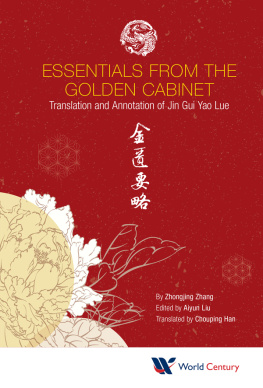

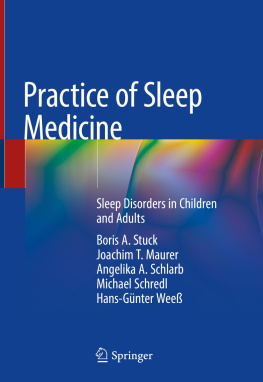

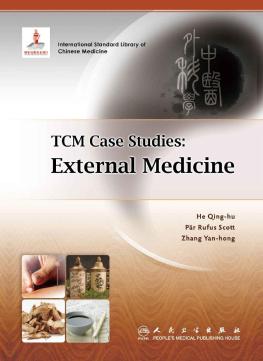
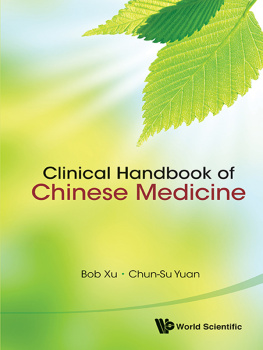
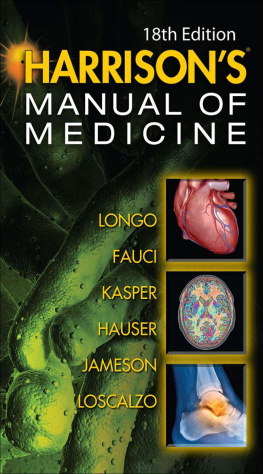


 Published by World Century Publishing Corporation 27 Warren Street, Suite 401-402, Hackensack, NJ 07601 Library of Congress Control Number: 2020938724 British Library Cataloguing-in-Publication Data A catalogue record for this book is available from the British Library. Supported by the Chinese Fund for the Humanities and Social Sciences Originally published in Chinese by Shanghai Chinese Classics Publishing House Copyright Shanghai Chinese Classics Publishing House 2016 English translation rights arranged with Shanghai Chinese Classics Publishing House ESSENTIALS FROM THE GOLDEN CABINETTranslation and Annotation of Jin Gui Yao Lue Copyright 2020 by World Century Publishing Corporation All rights reserved. This book, or parts thereof, may not be reproduced in any form or by any means, electronic or mechanical, including photocopying, recording or any information storage and retrieval system now known or to be invented, without written permission from the publisher. For photocopying of material in this volume, please pay a copying fee through the Copyright Clearance Center, Inc., 222 Rosewood Drive, Danvers, MA 01923, USA. In this case permission to photocopy is not required from the publisher. ISBN 978-1-945552-06-9 (hardcover) ISBN 978-1-945552-07-6 (ebook for institutions) ISBN 978-1-945552-08-3 (ebook for individuals) For any available supplementary material, please visit https://www.worldscientific.com/worldscibooks/10.1142/U034#t=suppl Printed in Singapore Preface The Jin Gui Yao Le (Essentials from the Golden Cabinet) is a classic book of traditional Chinese Medicine. It is the oldest clinical book dedicated to internal, external, gynecological and obstetrical diseases.
Published by World Century Publishing Corporation 27 Warren Street, Suite 401-402, Hackensack, NJ 07601 Library of Congress Control Number: 2020938724 British Library Cataloguing-in-Publication Data A catalogue record for this book is available from the British Library. Supported by the Chinese Fund for the Humanities and Social Sciences Originally published in Chinese by Shanghai Chinese Classics Publishing House Copyright Shanghai Chinese Classics Publishing House 2016 English translation rights arranged with Shanghai Chinese Classics Publishing House ESSENTIALS FROM THE GOLDEN CABINETTranslation and Annotation of Jin Gui Yao Lue Copyright 2020 by World Century Publishing Corporation All rights reserved. This book, or parts thereof, may not be reproduced in any form or by any means, electronic or mechanical, including photocopying, recording or any information storage and retrieval system now known or to be invented, without written permission from the publisher. For photocopying of material in this volume, please pay a copying fee through the Copyright Clearance Center, Inc., 222 Rosewood Drive, Danvers, MA 01923, USA. In this case permission to photocopy is not required from the publisher. ISBN 978-1-945552-06-9 (hardcover) ISBN 978-1-945552-07-6 (ebook for institutions) ISBN 978-1-945552-08-3 (ebook for individuals) For any available supplementary material, please visit https://www.worldscientific.com/worldscibooks/10.1142/U034#t=suppl Printed in Singapore Preface The Jin Gui Yao Le (Essentials from the Golden Cabinet) is a classic book of traditional Chinese Medicine. It is the oldest clinical book dedicated to internal, external, gynecological and obstetrical diseases.